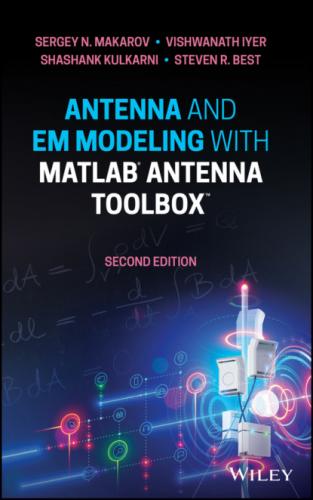SECTION 1 LUMPED CIRCUIT MODEL OF AN ANTENNA. ANTENNA INPUT IMPEDANCE
1.1 Antenna Circuit Model. Antenna Loss
1.2 Maximum Power Transfer to (and from) Antenna
1.4 Antenna Input Impedance and Impedance Matching
1.5 Point of Interest: Input Impedance of a Dipole Antenna and Its Dependence on Dipole Length
1.6 Beyond the First Resonance
1.1 ANTENNA CIRCUIT MODEL. ANTENNA LOSS
The generic transmitter (TX) circuit with an antenna is shown in Figure 1.1. The generator (g) is modeled as an ideal (sinusoidal or pulse) voltage source Vg in series with the generator resistance Rg, connected to a TX antenna. The typical generator resistance is 50 Ω. This model is known as Thévenin equivalent of the generator circuit. The Norton equivalent may also be used when necessary.
Figure 1.1 A generator (its Thévenin equivalent) connected to an antenna.
The portion depicted in the shaded box is an antenna. The antenna in Figure 1.1 is assumed to be resonant, which means that its equivalent impedance, Za, is purely real, i.e.
(1.1)
In order words, the resonant antenna is simply modeled by a resistor Ra.
The antenna resistance Ra includes two parts:
1 Radiation resistance of the antenna Rr that describes the circuit power loss due to radiation by the antenna into free space.
2 Loss resistance of the antenna RL that describes the circuit power loss in the antenna itself. Case in point: a long thin wire with a significant ohmic resistance or a helical antenna with a ferrite lossy core.
One thus has
(1.2)
Parasitic antenna resistance RL has the following features:
1 it is zero for ideal antennas (a metal antenna made of perfect electric conductors);
2 it is usually relatively small for metal antennas covering the band 0.3–3 GHz (UHF, L‐band, S‐band) where it may be often ignored;
3 it may be very significant for printed antennas on lossy dielectric substrates and in the vicinity of lossy dielectric (such as FR4, ABS, human body, etc.);
4 it is vital for very small antennas whose size is much less than the wavelength.
Example 1.1
A small antenna operating at f = 10 MHz uses a thin copper wire with the diameter D of 0.25 mm and with the wire length l of 1 m. Calculate antenna loss resistance RL.
Solution: The DC resistance of the wire is given by
(1.3)
where σ is the material conductivity and A is the wire cross section. However, we cannot use this formula since most of the high‐frequency current flows in a thin skin layer around the wire. The correct result has the form:
(1.4)
where P is wire perimeter and μ0 is vacuum permeability. A short MATLAB script given below accomplishes the task and gives RL approximately equal to 1 Ω. This value may be comparable to the radiation resistance of a small antenna, and may even exceed it.
clear all; mu = 4*pi*1e-7; % Vacuum permeability, H/m sigma = 5.7e7; % Copper conductivity, S/m D = 0.25e-3; % Diameter, m l = 1; % Length, m f = 10e6; % Frequency, Hz RHF = l/(pi*D)*sqrt(mu*2*pi*f/(2*sigma)) % Loss resistance
1.2 MAXIMUM POWER TRANSFER TO (AND FROM) ANTENNA
One question you have to ask yourself is this: for a fixed resistance Rg, can the electric power delivered to the antenna be maximized, and at which value of Ra does the maximum occur? In other words, we would like to know what parameters the antenna should have in order to acquire and radiate maximum electric power from the given RF generator (an RF amplifier). In an electric circuit, the passive load – the antenna – may have only one such parameter – the antenna resistance. All other antenna parameters (geometrical, material, etc.) are implicitly included into antenna's resistance.
The answer is given by the maximum power transfer theorem and found by solving the circuit in Figure 1.1. We assume that voltages and current are all functions of time and solve the circuit for an arbitrary time moment. First, the current is determined from the given voltage source υg(t) and the total resistance using the series equivalent,
(1.5a)
This allows us to compute the (instantaneous) power delivered to the antenna based on
For a generator with fixed resistance Rg, the load resistance determines the power Pa(t) at any time instant. Eq.
